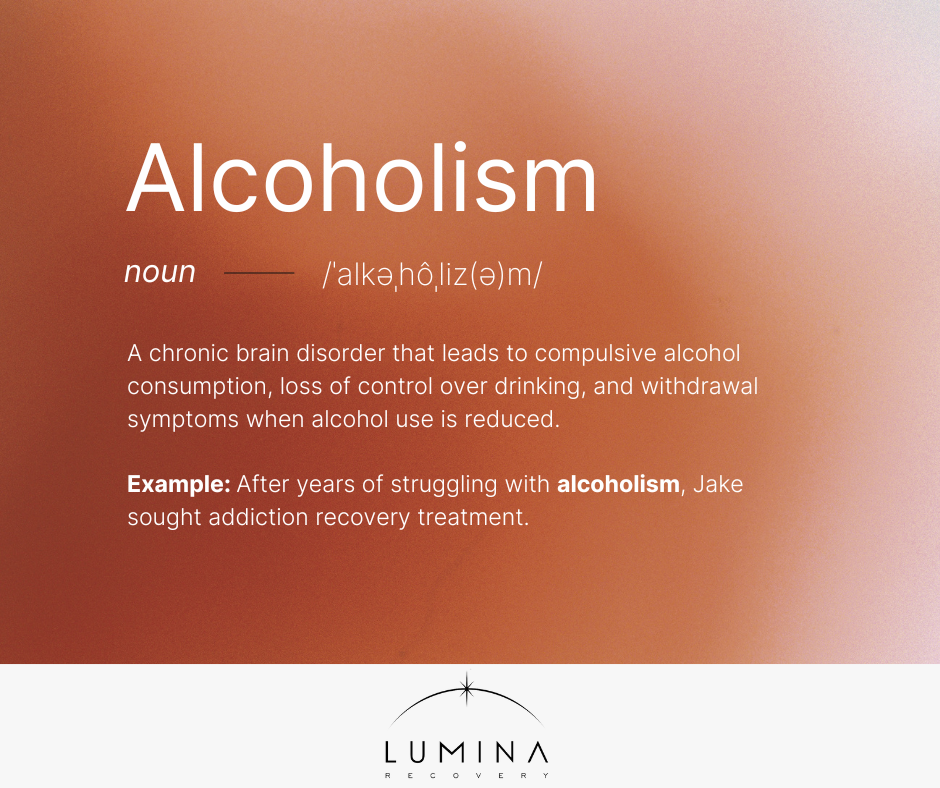The definition of alcoholism, also known as alcohol use disorder (AUD), is a chronic disease that affects millions worldwide, impacting physical health, mental well-being, and relationships. According to the National Institute on Alcohol Abuse and Alcoholism (NIAAA), nearly 28.9 million people in the U.S. had an AUD in the last year.1
Alcoholism is a complex issue that affects not only individuals but also families and communities. From understanding the medical definitions to recognizing alcoholism’s impact on mental health, relationships, and society, we aim to provide valuable insights.
How Is Alcoholism Defined?
Alcoholism is defined as a chronic brain disorder that leads to compulsive alcohol consumption, loss of control over drinking, and withdrawal symptoms when alcohol use is reduced.
The NIAAA classifies alcohol use disorder as a medical condition that ranges from mild to severe based on diagnostic criteria. Unlike casual drinking, what constitutes alcoholism is its impact on both brain function and behavior, leading to a destructive cycle of dependence.2
What is considered alcoholism varies from person to person, but the stages of alcoholism and common indicators include excessive drinking, continued alcohol use despite adverse consequences, and strong cravings. Some people may develop alcoholism gradually, starting with occasional binge drinking before becoming physically dependent.
Signs and Symptoms of Alcoholism
What is alcoholism? Recognizing alcoholism involves identifying behavioral, physical, and mental symptoms that indicate dependency:3
Behavioral Symptoms
- Drinking more or longer than intended
- Neglecting responsibilities at work, school, or home
- Social withdrawal and increased secrecy about drinking
- Drinking in situations where it is dangerous, such as driving
- Continuing to drink despite interpersonal conflicts or strained relationships
Physical Symptoms
- Withdrawal symptoms like shaking, sweating, or nausea
- Increased tolerance requires more alcohol for the same effect
- Blackouts or memory loss
- Fluctuations in weight due to changes in appetite
- Frequent hangovers that impact daily functioning
Mental Symptoms
- Anxiety and depression linked to alcohol use
- Increased impulsivity and risk-taking behavior
- Mood swings and irritability
- Feeling guilty or ashamed about drinking habits
- Using alcohol as a way to cope with stress, sadness, or trauma
Health Risks and Consequences
Alcohol abuse can have both immediate and long-term effects on the body and mind, leading to severe health complications if left untreated:3
Short-Term Effects
- Impaired judgment leading to accidents and injuries
- Alcohol poisoning, which can be life-threatening
- Increased risk of violence and risky behaviors
- Slurred speech and lack of coordination
- Weakened immune system, making the body more susceptible to infections
Long-Term Effects
- Liver disease (cirrhosis, fatty liver disease)
- Cardiovascular problems, including high blood pressure and stroke
- Increased risk of mental health disorders like depression and anxiety
- Damage to the digestive system, leading to ulcers and malnutrition
- Decline in cognitive function, including memory loss and difficulty concentrating
- Increased risk of cancers including throat, mouth, breast, colon, and liver
Causes and Risk Factors
Understanding the causes and risk factors of alcoholism is essential in identifying those at higher risk and finding effective prevention and treatment strategies:
Genetics & Family History
- Studies suggest 50-60% of alcoholism cases have a genetic component4
- Having a close family member with AUD increases the risk
- Genetic predisposition combined with environmental factors can accelerate alcohol dependence
Environmental Factors
- Social norms and peer pressure surrounding alcohol use
- Childhood trauma, abuse, or neglect
- Stressful work environments or high-pressure careers
- Easy access to alcohol in social or cultural settings
Psychological Factors
- Stress and chronic anxiety
- Co-occurring mental health disorders like bipolar disorder or PTSD
- Low self-esteem and self-medicating with alcohol
How Is Alcoholism Diagnosed?
Determining whether someone has alcoholism involves assessing behavioral patterns, physical dependence, and psychological factors to ensure proper treatment.
DSM-5 Criteria for AUD
The Diagnostic and Statistical Manual of Mental Disorders (DSM-5) provides a framework for identifying alcohol-related conditions, with alcoholism defined as a disorder that meets at least two of the following criteria within a year:5
- Consuming more alcohol than originally planned.
- Unsuccessful efforts to reduce alcohol intake.
- Devoting a significant amount of time to obtaining, using, or recovering from alcohol.
- Failing to meet crucial obligations at work, school, or home due to alcohol consumption.
- Feeling a strong urge or compulsion to drink when not consuming alcohol.
- Continuing alcohol use even when it causes conflicts in personal relationships.
- Cutting back or completely abandoning social, professional, or leisure activities because of alcohol use.
- Engaging in dangerous behaviors, such as driving under the influence.
- Persisting in alcohol consumption despite known physical or psychological health issues.
- Needing to drink more alcohol over time to achieve the same effects.
- Experiencing physical or mental withdrawal symptoms when alcohol use is reduced or stopped.
Treatment and Recovery Options
There are a variety of treatment options for those with alcoholism. From rehab to therapy, there are many programs to suit your individual needs.
Detox and Rehabilitation Programs
Detox and rehabilitation programs are essential for individuals seeking to overcome alcoholism. Medically supervised detox helps manage withdrawal symptoms safely, ensuring a more comfortable transition to sobriety.
Residential inpatient programs offer structured recovery environments, providing continuous support and therapy. For those with work or family responsibilities, outpatient treatment programs offer flexible recovery options without requiring a stay at a treatment facility.
Therapy
Therapy plays a crucial role in treating alcoholism. Cognitive behavioral therapy (CBT) helps individuals identify and change thought patterns that contribute to drinking behaviors. Dialectical behavior therapy (DBT) provides strategies for managing emotions and reducing harmful behaviors related to alcohol use.
Eye movement desensitization and reprocessing (EMDR) is particularly effective for those whose alcohol use is linked to trauma. Individual therapy offers personalized support, helping clients explore the root causes of their addiction. Family therapy can also be beneficial, as it helps rebuild relationships affected by alcohol use and fosters a supportive home environment.
Support Groups
Support groups provide ongoing encouragement and community for those in recovery. Alcoholics Anonymous (AA) offers peer support through the well-known 12-step program, fostering accountability, and shared experiences.
SMART Recovery provides a science-based approach, focusing on self-empowerment and evidence-based techniques. Online support groups are also available, offering flexible ways for individuals to connect with others on the same journey toward sobriety.
Frequently Asked Questions (FAQs)
What is the best definition of alcoholism?
Alcoholism, or alcohol use disorder (AUD), is a long-term mental illness that impairs a person’s ability to regulate their drinking, even when it leads to harmful outcomes. This disorder often includes physical reliance on alcohol, persistent cravings, increased tolerance, and withdrawal symptoms.
What is the legal definition of alcoholism?
The legal definition of alcoholism varies by jurisdiction but generally refers to a medical condition in which a person’s excessive alcohol use impairs their ability to function.
What is technically considered alcoholism?
Technically, alcoholism is considered a disorder when an individual meets the criteria outlined in the Diagnostic and Statistical Manual of Mental Disorders (DSM-5) for alcohol use disorder.
Get Help for Alcoholism With Lumina Recovery
Understanding what alcoholism is and how it is defined is the first step toward change. At Lumina Recovery, we offer personalized treatment plans that include medically supervised detox, inpatient rehab, therapy, and dual diagnosis treatment for co-occurring mental health conditions.
If you or a loved one is struggling with alcoholism, reach out to Lumina Recovery today to take the first step toward a healthier future.
Sources:
- National Institute on Alcohol Abuse and Alcoholism. Alcohol Use Disorder (AUD) in the United States: Age Groups and Demographic Characteristics.
- National Institute on Alcohol Abuse and Alcoholism. Understanding Alcohol Use Disorder.
- Mayo Clinic. Alcohol use disorder.
- National Institute on Alcohol Abuse and Alcoholism. Risk Factors: Varied Vulnerability to Alcohol-Related Harm.
- National Institute on Alcohol Abuse and Alcoholism. Alcohol Use Disorder: From Risk to Diagnosis to Recovery.




